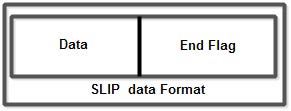• This protocol was developed by Rick Adams in 1984.
• The initial purpose of this protocol was to connect Sun workstation to the Internet over a dial-up line using modem.
• Using this protocol, workstations sends raw IP packets over the line with a flag byte (OXCO) at the end for framing purpose.
• If the flag byte occurs inside the IP packet, then character stuffing technique is used to solve this problem. For this a two byte sequence (OXDB, OXDC) is sent in its place.
• Although SLIP is the simple protocol but it has some major problems. These are:
1. It does not perform any error detection and correction.
2. SLIP support only IP (Internet Protocol). So it cannot be used for other networks that do not make use of IP (for e.g. Novell LANs).
3. It does not Support the allocation of dynamic IP address. Both the communication sites should be assigned a specific IP address before hand and both sites should know each other’s address.
4. SLIP does not provide any authentication. So both the communicating sites do not know with whom they are communicating.
5. SLIP is not an approved Internet standard; so many different and incompatible versions exist that makes networking difficult.
• The data format of SLIP is shown in fig.

• A special END character (equivalent to decimal 192) marks the end of data.
• If an End character occurs naturally in data, SLIP includes a special ESC character before the END character so that receiving computer does not prematurely stop receiving the packet.
 Dinesh Thakur holds an B.C.A, MCDBA, MCSD certifications. Dinesh authors the hugely popular
Dinesh Thakur holds an B.C.A, MCDBA, MCSD certifications. Dinesh authors the hugely popular